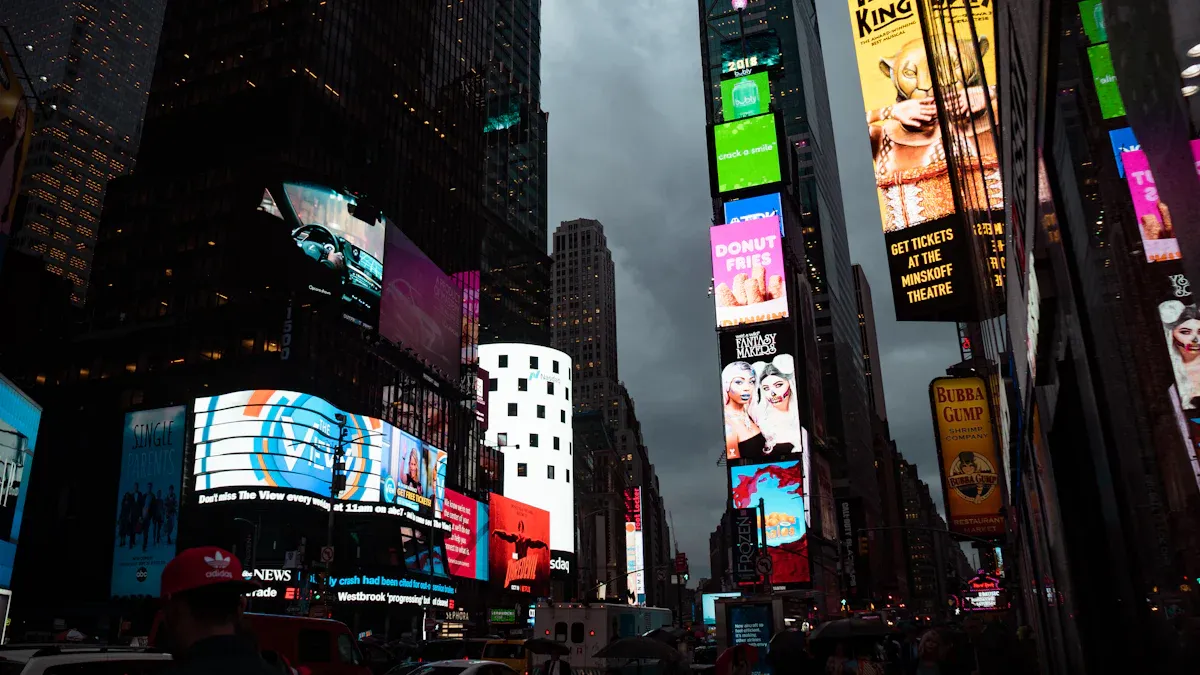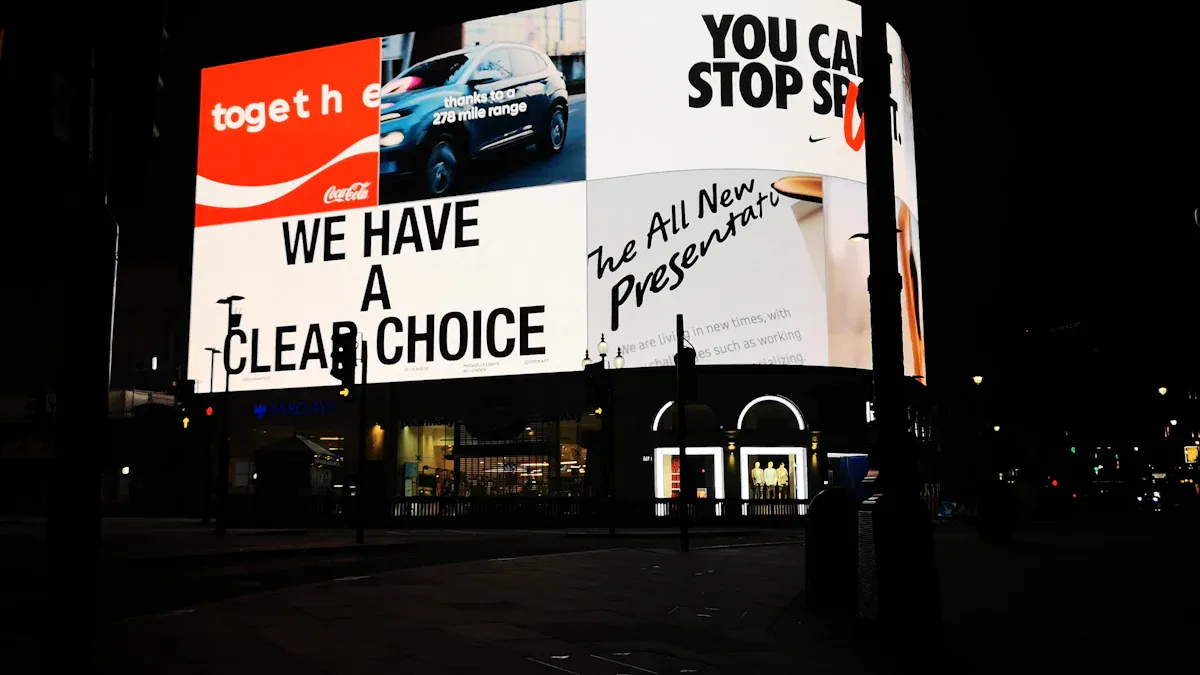Digital Signage in retail environments focusing on strategic placement and content optimization

Digital signage transforms retail environments by capturing customer attention and influencing purchase decisions. Strategic placement in high-traffic zones and content tailored to shopper behavior deliver impressive results. Stores have seen sales increase by up to 30% and customer satisfaction rise by 46%. A Fortune 1000 company boosted net income by $65 million through data-driven digital signage strategies.
Retailers aiming for growth should evaluate how digital signage can shape customer journeys and drive measurable outcomes.
Key Takeaways
Place digital signage in busy store areas like entrances and checkout lines to catch more customer attention and boost sales.
Use clear, short messages with strong calls to action and personalize content based on customer behavior to increase engagement.
Choose reliable, bright screens and ensure signs are visible at eye level for the best customer experience.
Update content regularly and schedule messages to match the time of day for more relevant and effective promotions.
Track performance with analytics to see what works, then adjust placement and content to keep improving results.
Digital Signage Strategy
Objectives
A successful digital signage strategy begins with clear objectives. Retailers set goals to drive engagement, boost sales, or enhance brand awareness. Well-defined objectives shape every aspect of digital signage, from content to placement.
Concise, high-impact content captures attention within 3-5 seconds. Headlines stay under seven words, using bold, high-contrast fonts.
Strong calls to action, such as "Scan for Discounts," prompt immediate responses.
Motion graphics and short video clips increase engagement compared to static images.
Personalization and localization, including dayparting and demographic targeting, make messages timely and relevant.
Placing screens in high-dwell or eye-level areas maximizes visibility and impulse buying.
Interactive features like touchscreens and QR codes encourage direct customer engagement.
Case studies show that digital signage with clear objectives can increase sales by nearly 30%.
A focused digital signage strategy ensures every screen serves a purpose and delivers measurable results.
Audience
Understanding the target audience stands at the core of any digital signage strategy. Retailers use analytics to learn about customer demographics, interests, and behaviors. This knowledge allows them to deliver the right message at the right time, making content more memorable and effective.
Coca-Cola displayed ads in high-traffic areas during peak times, increasing engagement.
Toyota monitored ad placement to confirm messages reached the intended audience.
McDonald’s optimized timing and locations for menu promotions using performance data.
Starbucks linked ad displays to sales figures to measure campaign impact.
Digital signage analytics reveal customer characteristics and preferences, enabling personalized content and scheduling. This approach helps brands share their story and achieve business goals.
Technology
Selecting the right technology forms the backbone of an effective digital signage strategy. The choice of hardware and software impacts visibility, reliability, and long-term value.
Benchmark Aspect | Key Details & Metrics |
|---|---|
TV Type | Commercial TVs support continuous operation (12/7, 20/7, 24/7); consumer TVs max out at 7 hours. |
Brightness (nits) | Indoor: 400-600; well-lit: 600-1000; direct sunlight: 1000-2500. |
Display Size & Resolution | Match to viewing distance for clarity and engagement. |
Content Player | Must handle content complexity and work with signage software. |
Mounting & Safety | Ensure proper support, viewing angle, and compliance. |
Power & Connectivity | Reliable power and network connections are essential. |
Maintenance & Support | Warranty, technical support, and scalability ensure long-term success. |
Retailers who invest in robust technology create a seamless digital signage experience that adapts to changing needs and environments.
Placement

High-Traffic Zones
Retailers achieve the greatest impact with digital signage by focusing on high-traffic zones. These areas include entrances, main walkways, and waiting spaces where customers naturally gather. Strategic placement in these locations increases the likelihood that shoppers will see and engage with content. Digital signage in high-traffic zones captures 400% more views than static signs. Target reported a 23% increase in foot traffic in departments with digital signage, while McDonald's saw a 15% rise in optional add-ons after installing digital menu boards. Intel research found that digital signage can boost average purchase amounts by 29.5% and customer satisfaction by 46%.
Retailers use analytics to track customer movement and dwell times, allowing them to refine display placement and maximize exposure. By analyzing these patterns, they can adjust merchandising strategy to highlight high-demand products and drive immediate purchases with real-time promotions. This approach turns casual onlookers into active shoppers, improving the in-store experience and influencing behaviour.
Visibility
Visibility plays a critical role in effective display placement. Retailers must position digital signage at eye level and ensure it remains unobstructed. Displays should be easy to read from typical viewing distances, with appropriate brightness and contrast for the store environment. Merchandising strategy benefits from placing screens where customers pause, such as entrances or checkout lines.
Tip: Walk through the store from a customer's perspective, including people of different heights, to check if all signs are visible and accessible.
Retailers also consider viewing patterns:
Point of transit: Customers glance quickly while moving. Use short, rotating messages.
Point of wait: Customers spend more time in one spot. Provide detailed content.
Point of sale: Shoppers focus on purchases. Highlight promotions and add-ons.
Visibility metrics show that over 80% of customers notice and engage with signs placed at eye level. Integrating digital signage with other visual elements creates a cohesive in-store experience. Studies reveal that 65% of customers find stores more appealing when digital signs blend with the overall design. This integration supports a strong merchandising strategy and enhances brand identity.
Store Flow
Store flow describes how customers move through a retail space. Merchandising strategy uses display placement to guide this movement and influence behaviour. Retailers analyze in-store experience data to identify bottlenecks and high-traffic paths. By placing digital signage along these routes, they can direct attention to featured products or promotions.
Research shows that changing product and display locations can shift customer behaviour. For example, supermarkets that moved fresh produce near entrances saw increased fruit and vegetable sales and reduced confectionery purchases. This approach demonstrates how strategic placement and reductive merchandising strategy shape the customer journey. Removing unhealthy items from prominent spots and highlighting healthier options guide shoppers toward better choices.
Retailers like Amazon Go and Walmart use advanced analytics to monitor customer paths and optimize display placement. These insights help refine store layouts, improve inventory management, and create a seamless in-store experience. Lululemon leverages customer analytics to tailor promotions and product recommendations, building brand loyalty and increasing sales.
Place digital signage at key decision points to nudge behaviour.
Use data to reposition displays and products for maximum impact.
Continuously test and adjust merchandising strategy based on customer feedback and analytics.
Effective display placement, informed by analytics, enhances the in-store experience and drives measurable improvements in behaviour and sales.
Content Optimization

Personalization
Personalization stands at the heart of effective digital signage. Retailers use data to tailor messages for each shopper, making every visit feel unique. Digital signage adapts content based on customer demographics and shopping behavior. For example, McDonald's "Create Your Taste" campaign allowed customers to build their own burgers using touchscreens, which increased both engagement and order accuracy. Nike displayed real-time fitness data on screens, creating immersive experiences that boosted sales. Coca-Cola's "Share a Coke" campaign showed personalized names on bottles, sparking excitement and driving purchases.
Personalized digital signage also uses interactive features. Touchscreens let shoppers explore products and receive recommendations. QR codes and mobile integration provide access to special offers and information. Displaying real-time reviews and ratings adds social proof, building trust and influencing decisions. These strategies reduce wait times and create a smoother shopping experience. When retailers use personalization, they see higher audience engagement and more loyal customers.
Tip: Use customer purchase history and behavior data to deliver targeted promotions and recommendations, making each shopper feel valued.
Dayparting
Dayparting means scheduling content to match the time of day and shopper activity. Retailers see better results when they show breakfast deals in the morning and dinner specials in the evening. This approach makes ads more relevant and increases the chance of action. Dayparting improves audience engagement by aligning messages with peak activity times. It also boosts conversion rates and reduces wasted ad spend by avoiding less effective time slots.
Retailers collect data on viewer engagement, dwell times, and demographics. Analytics help them schedule content when and where shoppers pay the most attention. Integration with sales data links content timing to real results. Brands like Sephora and Adidas use dayparting to deliver timely messages, leading to a 25% increase in product lift and a 16x return on investment. Continuous testing and optimization ensure that content always performs at its best.
Dayparting tailors content to specific times, making ads more relevant.
It offers a competitive advantage by using optimal ad timing.
Flexible scheduling allows retailers to adapt quickly to changing shopper patterns.
Brand Consistency
Brand consistency builds trust and recognition. Retailers must use the same colors, logos, and messaging across all digital signage. Consistent branding increases recognition by up to 80%. When shoppers see familiar visuals, they feel more confident in their choices. Inconsistent branding, on the other hand, can confuse customers and reduce trust by 46%. For example, a major juice brand lost $50 million after changing its packaging, as shoppers no longer recognized the product.
Iconic brands like Coca-Cola and Apple show the power of unified branding. Their digital signage always matches their overall look and feel, which strengthens loyalty and trust. Retailers should ensure that every screen reflects their brand identity, from fonts to imagery. This approach supports content optimization and helps create a seamless in-store experience.
Note: Regularly review digital signage content to ensure it matches your brand guidelines and visual identity.
Dynamic Content
Dynamic content keeps digital signage fresh and relevant. Retailers use real-time updates to showcase new products, services, and promotions instantly. Live inventory updates help shoppers see what is in stock, improving decision-making. Dynamic promotions triggered by real-time data drive impulse purchases and increase sales.
Audience analytics allow retailers to target content based on age, gender, and behavior. Real-time impression analytics and conversion tracking help optimize campaigns. For example, interactive digital displays can show local weather data and recommend related products, such as umbrellas on rainy days. Real-time updates also provide important information like wait times and event schedules, enhancing the customer experience.
Dynamic content management improves operational efficiency by keeping information up to date.
Retailers achieve higher conversion rates and better upselling opportunities with instant content changes.
Interactive digital displays engage customers and encourage them to explore more products.
Retailers who embrace dynamic content see increased audience engagement and improved sales performance. Real-time information delivery allows them to adapt quickly to shopper needs, making every visit more engaging and productive.
Analytics
Measuring Impact
Retailers rely on analytics to measure the impact of digital signage. They use both quantitative and qualitative methods to understand how displays affect customer experience and sales data. Real-time data from digital signage systems tracks engagement rates, content performance, and peak viewing times. This information helps retailers see which messages work best and when customers interact most.
Metric | Description | Impact on ROI / Evidence |
|---|---|---|
Gross Margin Return on Investment (GMROI) | Measures gross margin earned per dollar invested in inventory. Helps identify best products and pricing strategies. | High GMROI indicates strong profitability; data-driven adjustments improve product performance. |
Inventory Turnover Rate | Rate at which products are sold and replaced. High turnover reduces holding costs and waste. | Optimized turnover leads to better cash flow and less obsolete stock. |
Sales per Square Foot | Efficiency of store layout and inventory space usage. | Data-driven layout optimization increases sales and store profitability. |
Customer Lifetime Value (CLV) | Revenue generated by a customer over their relationship. Guides marketing and retention efforts. | Higher CLV reflects successful long-term customer engagement, boosting profitability. |
Audience Engagement Metrics | Real-time tracking of engagement, content performance, and peak viewing times. | Enables continuous optimization of digital signage content, improving sales attribution and effectiveness. |
Qualitative Feedback | Customer and employee surveys and interviews. | Validates improvements in brand perception and customer satisfaction, complementing quantitative data. |
Retailers also use playback reports, device statistics, and proof of play logs to confirm content delivery and system uptime. These analytics tools support data-driven decision-making and help optimize both placement and content.
Continuous Improvement
Continuous improvement depends on regular analysis of sales data and customer experience feedback. Retailers review content statistics, event logs, and qualitative feedback to refine their digital signage strategy. They use A/B testing to compare different messages and layouts, making changes based on what drives higher engagement rates and sales.
Tip: Combine real-time data with customer surveys to get a full picture of what works best in your store.
Retailers like Zara and Walmart have shown that integrating analytics with digital signage leads to better inventory management and higher profits. By monitoring sales data and customer experience, they adjust campaigns quickly and keep content relevant. This approach ensures that digital signage remains effective and continues to deliver value.
Case Studies
Success Stories
Retailers have achieved impressive results by adopting digital signage strategies tailored to their environments. The following table highlights how leading brands have used digital signage to drive engagement, sales, and customer satisfaction:
Retailer | Digital Signage Strategy | Key Outcomes |
|---|---|---|
McDonald's | Digital kiosks at point of sale for ordering and payment | Improved order accuracy, faster service, upselling, enhanced customer experience |
Adidas | Digital screens in pop-up stores with interactive mirrors | Increased foot traffic, higher engagement, social media buzz, dynamic real-time promotions |
Sephora | In-store digital screens bridging online and offline | Boosted cross-channel sales, personalized recommendations, AR try-on, seamless shopping flow |
Tesla | Interactive touchscreens and VR in showrooms | Educated customers, increased sales conversions, immersive brand experience, data insights |
A recent case study by AIScreen showed a 25% increase in sales and a 40% rise in customer engagement after retailers placed digital signage in strategic locations. Quality Roots, a cannabis retailer, reported monthly savings of $3,000 to $5,000 per store by monetizing screen time. They also saw longer customer visits, more repeat business, and positive reviews. These examples show that digital signage can deliver both financial and experiential benefits.
Lessons Learned
Retailers have gained valuable insights from digital signage implementations. Key lessons include:
Integration is critical. Connecting digital signage with inventory, pricing, loyalty, and point-of-sale systems enables real-time updates and dynamic promotions. This prevents advertising out-of-stock items and maximizes sales opportunities.
Balanced content strategy works best. Combining informational content with inspirational stories increases engagement. FreshMarket found that a 40% promotional and 60% educational mix led to higher sales and stronger customer loyalty.
Associate engagement boosts results. Training store associates to use digital signage in customer interactions improves key performance indicators. Feedback from staff helps keep content relevant and increases buy-in.
Advanced analytics drive improvement. Using AI and analytics to track customer behavior and sales impact supports continuous optimization. Integrating data from multiple sources helps retailers make better decisions.
Strong ROI is possible. FreshMarket achieved a payback period of 22 months and a five-year ROI of 215%. Well-executed digital signage strategies can deliver measurable financial returns.
Tip: Retailers who review these lessons and adapt their strategies see the greatest long-term success.
Retailers can maximize results by following these steps:
Set clear goals for digital signage and select hardware that fits the store layout.
Place screens at eye level in high-traffic areas to boost visibility.
Use interactive features and timely promotions to engage shoppers.
Keep branding consistent and content relevant to build trust.
Monitor performance and update displays based on real-time data.
A data-driven digital signage strategy helps retailers drive sales and improve customer experience. Retailers should review their approach often and look for new ways to innovate.
FAQ
What is the best location for digital signage in a retail store?
Retailers see the most impact by placing digital signage in high-traffic areas. Entrances, checkout lines, and main walkways help maximize visibility and customer engagement.
How often should retailers update digital signage content?
Retailers should update content regularly. Weekly updates keep promotions fresh. Real-time updates work best for inventory changes or special events.
How can digital signage improve return on investment (ROI)?
Digital signage increases sales, reduces printing costs, and improves customer experience. Retailers track performance with analytics to measure ROI and adjust strategies for better results.
What technology features matter most for digital signage?
Key features include high-brightness screens, reliable content management software, and strong network connections. Touchscreens and interactive elements also boost customer engagement.
See Also
Customized Digital Signage Solutions For Retail Healthcare And Business
Maximizing Return On Investment Through Digital Signage Deployment
Effective Digital Signage Techniques For Clear Information Sharing
Exploring Digital Signage Technology Benefits And Deployment Methods

